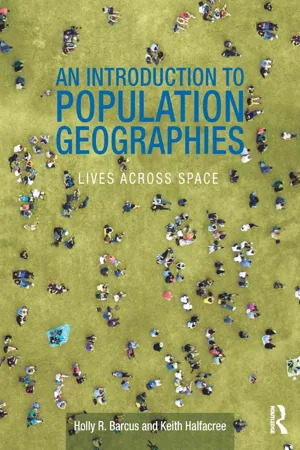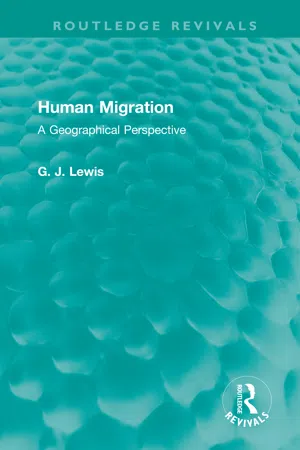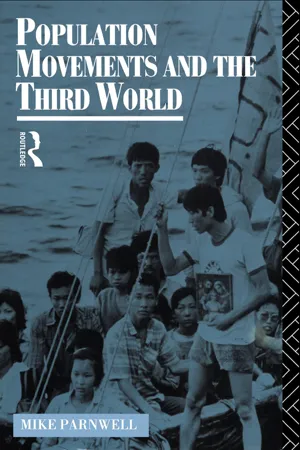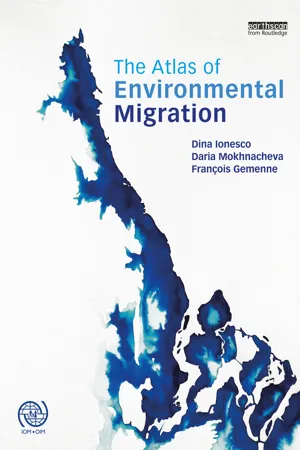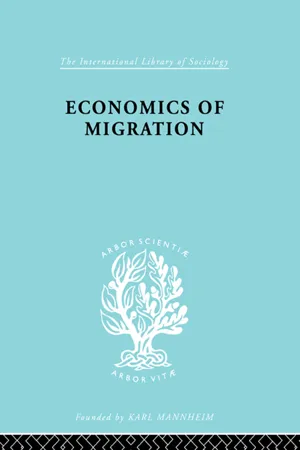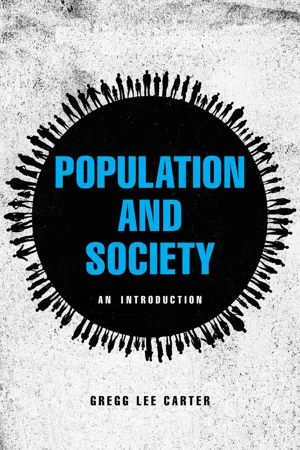Geography
Voluntary Migration
Voluntary migration refers to the movement of people from one place to another by their own choice, often in search of better opportunities, improved living conditions, or personal reasons. This type of migration is driven by individual decision-making and is not forced by external factors such as conflict or persecution. It is a key aspect of population geography and has significant social and economic implications.
Written by Perlego with AI-assistance
Related key terms
10 Key excerpts on "Voluntary Migration"
- eBook - ePub
Governing Climate Induced Migration and Displacement
IGO Expansion and Global Policy Implications
- Andrea C. Simonelli, Kenneth A. Loparo(Authors)
- 2016(Publication Date)
- Palgrave Macmillan(Publisher)
The politicization of migration has continued and strengthened in recent years. The 1990s saw political discourse in the richest countries that immigration was out of control (Papademetriou, 1997/1998). Much of this can be attributed to a misunderstanding of the dynamics of migration. As Mangalam and Schwartzweller (1968) argue, migration is not a random event, it cannot be understood by approaching it like bird migration, it is a social, not an individual behavior, and while each case of migration can have superficial differences, patterns can be connected between movements. Each nation tends to see its own unwanted immigration in isolation. Thus, there has been a global tightening of borders for legal and illegal migrants as well as asylum seekers. A new legitimizing ideology has developed to justify this inequality. The hierarchization of the right to migrate can be seen as a form of transnational racism which posits the “naturalness” of violence in less developed regions and other perceived cultural incompatibilities with non-Western peoples (Castles, 2007). Even the field of migration studies has been driven by political considerations. Research questions and even some findings have been pushed by government officials who can undermine the scientific nature of investigation in this area and has isolated migration studies from broader social inquiry. Politicians believe that if they can work out the root causes of international migration, they can reduce it. This attitude suggests that immigration is a bad thing that ought to be stopped (Castles, 2009).Voluntary MigrationThe study of modern migrations is most often derived from ideas about economic utility. It is based on immigration patterns and the idea that people move by choice for better economic or living conditions. This movement is usually classified as voluntary in that the move is a tacit choice based on conditions that either pull or push them out. However, there are distinct differences between push and pull factors; those include the lack of economic opportunities, jobs, land, and freedoms, respectively, as well as political repression (Belton and Morales, 2009). One is pulled out by a better job opportunity, while one is pushed out by not being able to pay one’s bills. While both are economic-based, there is a clear difference between the two. Much of the Voluntary Migration literature which emphasizes economic pull factors relates to globalization and the individual desire to improve one’s economic condition in the world. Shaw (1975) explains that this approach is guided by the idea that man is economically rational, an economic maximizer, and that he will perceive and evaluate migration options from this point of view. This is an opinion which is posited from the outside in that the migrant is not consulted to understand if that was indeed his/her motivation. Stark and Taylor (1989) reinforce this view by providing evidence that international migration is influenced by both relative as well as absolute income considerations. However, their research demonstrates that migration motives have more to do with one’s relative income based on his/her peer’s versus a basic determination based on poverty. This adds support for other theories in the field, which argue that it is not the poorest that migrate, but those who have the means to do so; this is a consequence of globalization. Contending literature, however, argues that if migrants are asked about their motives, a different picture will prevail. Winchie and Carment (1989) demonstrate that non-monetary career reasons can also be important. Their research shows that having existing familial relations overseas can be an equally strong pull factor as the desire for economic mobility. - eBook - ePub
An Introduction to Population Geographies
Lives Across Space
- Holly R. Barcus, Keith Halfacree(Authors)
- 2017(Publication Date)
- Routledge(Publisher)
CHAPTER 5Placing human migration5.1 INTRODUCTION: DEFINING MIGRATION
5.1.1 What is migration?
Migration remains the most widely studied and examined element within Population Geography (Boyle 2003, 2004). Moreover, whilst Geographers have played a pivotal role in shaping our contemporary understanding of it, the topic is of interest to numerous academic disciplines, including Demography, Sociology, Political Science, Economics and Anthropology (Brettell and Hollifield 2008a). In this respect, approaching migration as it occurs within the life course has considerable potential for bringing together a scattered body of scholarship often fragmented by “disciplinary partitioning” (Olwig and Sørensen 2002: 7).But what exactly is migration? Initially put, as in a recent textbook, it is “the movement of people to live in a different place” (Holdsworth et al. 2013: 96) or a “permanent change in residence.” It is residential relocation. Or, as expressed in UK and US censuses, a migration is deemed to have occurred when one’s “usual address” has changed within the last 1 or 5 years, respectively (ONS 2013; USCB 2013). Simple, then, one might think! However, as Holdsworth et al. (2013: 98) also noted, careful consideration of these definitions immediately raises a host of questions: what precisely is meant by “different place,” “live in,” “permanent,” or “usual address”? Consequently, by the end of the present chapter, “migration” will have been demonstrated to be at least as complex and multi-dimensional a concept as Chapter 4 revealed “fertility” to be.Starting with the idea of “different place,” the type of areal unit(s) involved in a migration is an initial important consideration when defining it specifically. A crucial starting point is whether a political boundary is crossed during a move. For example, an individual could move from one county to another within the same US state or from one state to another. Both moves are conventionally described as intra-national or internal migration, because neither involves leaving the US. In contrast, a move from the US to Canada, crossing an international border, is an international migration - eBook - ePub
Human Migration
A Geographical Perspective
- Gareth J. Lewis(Author)
- 2021(Publication Date)
- Routledge(Publisher)
7
CAUSES OF MIGRATION
DOI: 10.4324/9781003183051-7Unlike birth and death, migration has no physiological component; rather it is a response by humans to a series of economic, social and political stimuli within the environment. Such stimuli take the form of attractiveness of a location which can be generated by changes within the environment or in a person’s value system. If, as a result of these changes, the person becomes dissatisfied with his home location, then a desire to migrate will be generated. The strength of the desire to migrate, and whether it is fulfilled or not, will vary according to the needs of the individual, the constraints upon him and the strength of the dissatisfaction (Pryor, 1975b). For example, according to Lord Eversley the vast exodus of labourers from the rural districts into the towns of England and Wales during the nineteenth century was due not only to ‘greater prosperity and the general rise of wages in the manufacturing and mining districts’, but also ‘to a growing disinclination to farm work among labourers in rural districts, to the absence of opportunities to them of rising in their vocation, and to a desire for the greater independence and freedom of life in towns’ (Eversley, 1907, 280). Within this listing of the factors explaining migration, two undifferentiated sets of forces appear to exist: on the one hand, there are stimuli to migrate created by changes within the environment and, on the other, changes in the personal motives of the individual.The analysis of migration causes has attracted considerable attention, in particular the decision to migrate, the decision where to migrate to, and the criteria involved in such decisions. Most of the emphasis of the research, however, has been on the latter aspect of the causal nexus (Cebula, 1980); the decision-making context having only recently become a focus of attention (see Chapter 8 - eBook - ePub
People on the Move
Studies on Internal Migration
- Leszek Kosi?ski, R.M. Prothero(Authors)
- 2023(Publication Date)
- Routledge(Publisher)
Introduction: The study of migration
DOI: 10.4324/9781003459538-1There has been much discussion about migration in recent years from students of population in various disciplines including geography. Although migration is an especially attractive research area for a geographer, the development of migration studies owes much to interdisciplinary efforts and it is impossible to draw sharp lines between different contributions. There are several reasons why geographers devote attention to the study of migration. The territorial redistribution of population is an attractive subject for a spatially-orientated discipline. Dynamic aspects have attracted more attention and at the present time interest in spatial processes and spatial interaction is of more concern in modern geography than a concern with spatial patterns. This results in increased interest in migration studies. More research into mobility is made possible by the availability of data which are more detailed and more reliable and more regionally orientated than in the past.Concepts in the study of migration
Since 1885, when Ravenstein first formulated his ‘migration laws’, a substantial literature has appeared concerned with the spatial mobility of population. A number of specific terms have been proposed and accepted. The need to define various concepts used in population studies led to the production of an international dictionary of terms (UN 1958 ), and the present discussion follows closely terminology suggested by the UN and developed later in other publications (UN 1970 ;Shryock et al. 1971).The term mobility is perhaps the most general concept in migration studies. It includes all kinds of territorial movements, both temporary and permanent, over various distances (Zelinsky 1971 ). Migration is much more restricted and relates to a permanent change of residence. An operational definition of migration requires that both temporal and locational criteria be more specifically defined. This operational definition may depend on the type of research or type of data which are available, or both. Usually, a migrant is defined as a person who moves from one administrative unit to another. Sometimes moves between the lowest units in the administrative hierarchy are omitted and only those between middle or higher rank units are considered. On the other hand, a migrant is considered to be a person who moves with the intention of establishing a new residence in a different country or a region. If he later changes his mind he will be considered a migrant again or, if he returns to the place of origin, a returning migrant. Alternatively, the migrant can be a person who will stay in a new residence for a minimum period of time, such as six months or one year. Some researchers distinguish between migrants, those who move between political units, and movers, those who move within them. Thus, at any given time the total population of a region can be divided into migrants and non-migrants, movers and non-movers. This classification establishes the mobility status - eBook - ePub
- Mike Parnwell(Author)
- 2006(Publication Date)
- Routledge(Publisher)
Whereas political refugees may leave behind all their worldly possessions, reservoir evacuees may at least be compensated financially for the loss of their land. Farmers and shifting cultivators affected by the Batang Ai hydroelectric power project in Sarawak, East Malaysia, were given quite large amounts of compensation which helped to overcome their misgivings at having to cede their ancestral land to the project. Some 90 per cent of the people displaced by the Damodar Valley projects in India opted for independent resettlement, using the compensation provided by the government to set themselves up in new locations. In the case of the Volta and Aswan dam projects in Africa, however, quite large numbers of displaced people eventually left the official resettlement areas, providing further evidence of the shortcomings of official resettlement programmes.Voluntary forms of population movementThe final category of population movements which will be described in this chapter involves forms of migration where the mover decides that his or her interests, be they economic, educational, social or whatever, would be better served by moving away from the home community to another place. Voluntary Migration is by far the most prevalent type of population movement in the Third World today, taking a wide variety of forms and occurring in response to a very wide range of circumstances. This section will briefly focus on just one form of voluntary movement: that which takes place across international boundaries (international migration). Another very important form of voluntary movement, that which occurs within a national territory (internal migration), provides the focus for discussion in the last three chapters of this volume.International migrationThe extent of international migration involving the Third World should not be underestimated. There are some 350 million people of African descent living outside Africa, compared with around 540 million inside the continent itself. Similarly, there are an estimated 22 million overseas Chinese, and almost 9 million South Asians living outside the sub-continent. In 1984 the International Labour Organization estimated the total stock of economically active international migrants to be between 19.7 and 21.7 million worldwide. - eBook - ePub
- Dina Ionesco, Daria Mokhnacheva, François Gemenne(Authors)
- 2016(Publication Date)
- Routledge(Publisher)
Mobility, a more consensual term, includes different forms of movement and refers to the ability to migrate, It also helps to circumvent the extremely blurred division between forced and Voluntary Migration. Independent of empirical reality, these terms are also political constructs that are useful for highlighting the growing importance of environmental degradation as a factor of migration. It is not so much a matter of creating a particular category of migration as of drawing attention, as this Atlas does, to a neglected factor, whose importance will increase in the future. An awkward definition How then can environmental migrants be defined? In the absence of a legal definition, or at least one that is internationally accepted, IOM's definition is often the one used: 'Environmental migrants are persons or groups of persons who, predominantly for reasons of sudden or progressive change in the environment that adversely affects their lives or living conditions, are obliged to leave their habitual homes, or choose to do so, either temporarily or permanently, and who move either within their country or abroad'. Deliberately broad, in order to encompass all types of population movement, this definition is under discussion within the academic community as it includes, by definition, a large number of people, a fact that may alarm certain governments and reduce their funding capacity in the future. If it is a given that all migration is intrinsically multi-causal, should the definition include all those who migrate on environmental grounds, be they marginal in the decision or not, or only those for whom environmental degradation is the determining factor? Should it only cover cases of forced migration or all forms of mobility? And what about forced immobility? All of these questions are not purely methodological, but also political, as the nature and wording of the definition will give rise to the formulation of responses - eBook - ePub
- Julius Issac(Author)
- 2013(Publication Date)
- Routledge(Publisher)
Chapter III Factors Determining Volume and Direction of MigrationIn the first chapter Migration was defined as the movement of free individuals from one country to another with the intention of effecting a lasting change in permanent residence. This implies that no migration can occur against the will of the migrant, or in the case of persons under age against the will of their parents or guardians. It is the object of this chapter, firstly, to inquire into the motives which may induce free individuals to leave the country of their permanent residence and which determine their choice of the country of immigration; secondly, to discuss the various counteracting forces which limit the scope of migratory movements in real life. Outstanding among these forces during the inter-war period were restrictions of immigration. Their effect was a marked contraction not only, in the volume of migration, but also in the choice open to the individual emigrant.1. Predominance of the Economic IncentiveThe decision to emigrate may obviously result from a number of motives, which may differ in each individual case. But, generally speaking, among these motives an economic consideration, the desire to become better off, has been predominant. The liberal theory of the economic effects of migration is, as we shall see in the next chapter, based on this assumption, on the abstractipn of the “economic man” who always wants to act in accordance with his best economic interests and also knows how to do so. This simplification may be regarded as a fairly realistic first approach to the problems of migration. Of course, not every individual who has the opportunity of becoming better off through migration has the desire to migrate, and not every would-be emigrant has the opportunity to do so—this will be elaborated in the third part of this chapter; but the movements which actually took place were mainly due to economic reasons.1 - eBook - ePub
Population and Society
An Introduction
- Gregg Lee Carter(Author)
- 2016(Publication Date)
- Polity(Publisher)
In some cases, governments have forced the population transfer of a particular ethnic or religious group from one region to another; and in other cases, the chaos and dread associated with civil wars, insurrections, revolutions, and persecutions have created a situation of impelled migration, in which individuals, families, and groups flee their homes in search of safe havens – often involving the crossing of national borders. The following briefly developed examples, one historical and one contemporary, illustrate the importance of this macro factor in explaining geographic mobility. Note that such examples could readily be drawn exclusively from almost any and all of the individual histories of the world's current 195 countries. The Africa to the Americas slave trade - eBook - ePub
Britain's Population
Demographic Issues in Contemporary Society
- Steven Jackson(Author)
- 2013(Publication Date)
- Routledge(Publisher)
Other factors which influence patterns of inter-regional movement include population structure. Life-cycle stage is significant in determining who will move and when. A significant amount of migration occurs at ‘transitional’ phases in people’s lives – particularly at the transition between education and employment and the transition between employment and retirement. Young adults are the most mobile group in the population, not only because of the diverse opportunities available for entry into the labour market, but also because of their general lack of commitments of home ownership and family rearing. As a consequence growth regions tend to attract a disproportionate share of young adults, and localities which are losing numbers become unbalanced in their structure. The destinations for retirement migrants similarly reflect the effects of age-specific migration, with an increasing burden placed on the health and social services for the care of an ageing population.Intra-regional mobility
Patterns of population movement between the regions may reflect the longerterm process of population redistribution in Britain. However, the majority of moves are over relatively short distances. Over 70 per cent of moves in Britain are over distances of 10 km or less – most of which would come under the heading of residential relocation rather than migration (Owen and Green 1991). People move house for a variety of reasons, depending on individual circumstances, but it is possible to identify aggregate patterns of movement from the overall volatility of local moves. One of the wellestablished trends is the process of ‘suburbanization’, brought about by a constant drift of population from the central areas of towns and cities towards newer housing developments on the periphery. This is not a new process and can be identified in Britain from the peak period of urban growth in the nineteenth century. - eBook - ePub
Ethnic Groups in Motion
Economic Competition and Migration in Multi-Ethnic States
- Milica Z. Bookman(Author)
- 2012(Publication Date)
- Routledge(Publisher)
While they do not weigh equally in a migrant’s decision (religious teaching has more impact than electrification, for example), these influences underscore that ethnic groups do not share advantages and impediments, nor do they face the same capacities and incentives. This ethnic difference in migration is even more pronounced during inVoluntary Migration (see chapter 5). It is also more pronounced when domestic policies induce a desired migration response (either to stay or to go) by harassing, restricting, and pressuring targeted ethnic groups (see chapters 6 and 7). Such restrictions to Voluntary Migration, both in home and host countries, support the contention that migration is, in reality, far from laissez-faire. In other words, pure laissez-faire migration, which entails unfettered movements of people in response to a variety of incentives, does not exist. Since migration is the way in which the manpower demands of economies are met, efficiency in labor markets is not achieved because labor does not flow to where demand exceeds supply. Thus, ethnic characteristics that influence the capacity and incentive to relocate have an impact on migration, as much as government restrictions that explicitly dictate who goes and who stays. NEW TRENDS IN LABOR MIGRATION: LONG-DISTANCE COMMUTING Immigrants today are not like the immigrants of yesterday. Many of them have neither severed their ties to their homeland, nor are permanently ensconced in their host country. They move around, they go back and forth, they make new ties and they maintain old ties. They participate in the politics and economies of everywhere they go. As a result of increased communications and cheaper transportation, location polygamy characterizes immigrant populations as never before
Index pages curate the most relevant extracts from our library of academic textbooks. They’ve been created using an in-house natural language model (NLM), each adding context and meaning to key research topics.

